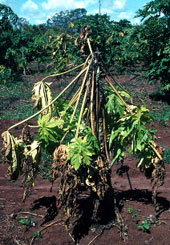
Dieback in pawpaw
An Australia first is occurring at Charles Darwin University with Bioscience North Australia (BNA) unlocking the secrets of a pathogen that causes disease in pawpaw and strawberries.
This is the third phytoplasma in the world to be completely sequenced.
BNA research has resulted in the sequencing of a plant pathogen associated with dieback and lethal yellows diseases in tropical and sub-tropical Australia.
The sequencing project is part of Lucy Tran-Nguyen’s PhD at Charles Darwin University (CDU), supervised by Associate Professor Karen Gibb.
Phytoplasmas are important plant pathogens but they cannot be cultured so it is very hard to purify sufficient DNA to sequence. Ms Tran-Nguyen used novel cloning strategies to overcome this difficulty.
It is not known how these pathogens interact with their plant and insect hosts, or how they cause disease. By sequencing the genome of this pathogen and comparing the sequence with other intracellular plant pathogenic bacteria and phytoplasmas, the genes associated with metabolism will be identified and advance an understanding of pathogenesis. This will allow us to develop more accurate diagnostic tests because we will have a wider range of genes and proteins to target.
The circular genome, which contains over 880,000 bases, has a minimal set of genes required for life. It is so dependent on the plant that it has lost most of the genes required for normal biochemical function.
The research is funded by the Cooperative Research Centre for Tropical Plant Protection and is based at CDU in the molecular facility Bioscience North Australia.
Collaborators in Ms Tran-Nguyen’s research include Dr Bernd Schneider from the Federal Biological Research Institute for Agriculture and Forestry, Institute for Plant Protection in Fruit Crops, Dossenheim, Germany, Dr Claire Streten (CDU) and Drs Michael Kube and Richard Reinhardt from the Max Planck Institute for Molecular Genetics, Berlin-Dahlem, Germany.
The hard work of Ms Tran-Nguyen and her collaborators is sure to result in many more BNA discoveries.
The support of the Queensland Department of Primary Industries and Fisheries which provided us with plant material, is gratefully acknowledged by the University.